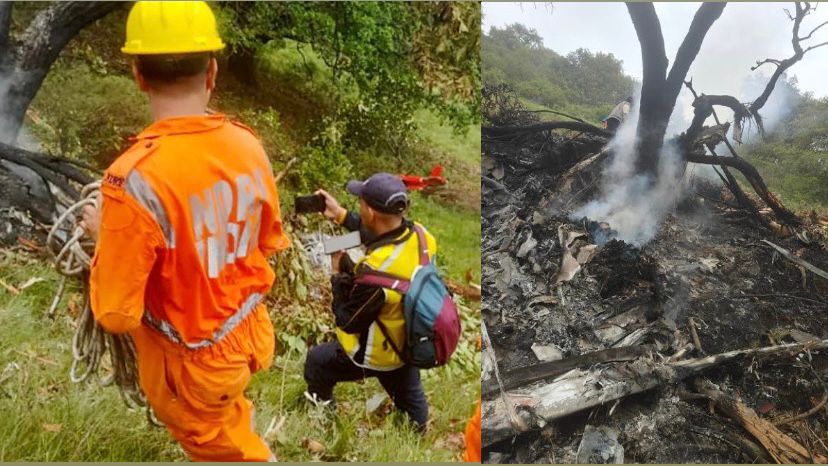
The Kedarnath Helicopter Incident: Tragic, 7 people were killed as the chopper flying them from the Kedarnath temple to Guptkashi, crashed in a forest, between Gaurikund and Sonprayag in Uttarakhand. The seven victims in the Aryan Aviation Helicopter crash included the pilot, at 5.20 am with 7 people on board – 6 passengers (including a child) and a pilot. The helicopter was fully gutted in flames. The pilgrims were from Uttarakhand, Uttar Pradesh, Maharashtra and Gujarat state. All the 7 bodies were recovered by NDRF
Kedarnath, nestled in the lap of the Himalayas in Uttarakhand, India, is not only a revered pilgrimage site but also a location that has witnessed both divine devotion and tragic disasters. One such heartbreaking event that shook the region and the nation was the Kedarnath helicopter incident. Though aviation services in such difficult terrains have significantly helped pilgrims reach the temple with ease, they also come with inherent risks. The helicopter accident at Kedarnath was a grim reminder of the critical need for strict safety protocols in high-risk areas.
What Happened In The Kedarnath Helicopter Crash?
On October 18, 2022, a helicopter carrying seven people, including the pilot and six pilgrims, crashed near the Garud Chatti area, just a few kilometers from the Kedarnath temple. All seven people lost their lives in the incident. The helicopter, operated by Aryan Aviation, was reportedly on its way from Kedarnath to Phata, a regular route for ferrying pilgrims during the Char Dham Yatra season.
Eyewitnesses reported that the helicopter caught fire moments after crashing, and locals nearby rushed to the spot to help. Unfortunately, by the time help could reach, it was too late to save any of the passengers. The incident occurred in challenging terrain, further complicating rescue and recovery operations.
Possible Causes and Investigation
Initial reports suggested poor visibility and bad weather conditions may have contributed to the crash. The helicopter was flying in foggy conditions, and experts later speculated that spatial disorientation or loss of situational awareness could have caused the pilot to misjudge the altitude or trajectory.
The Directorate General of Civil Aviation (DGCA) ordered an immediate investigation into the incident. Teams from the Aircraft Accident Investigation Bureau (AAIB) were dispatched to the site to examine black box data, pilot records, maintenance logs, and weather patterns at the time of the flight. Although full results of the investigation took time, the preliminary assessment pointed toward a mix of human error and unfavorable flying conditions.
Impact on the Pilgrimage Season
Kedarnath is one of the four sacred shrines of the Char Dham Yatra, and helicopter services have been a boon for pilgrims who are elderly, physically weak, or time-constrained. The helicopter services reduce a long and difficult 16–18 km uphill trek to a 10-minute flight.
After the Kedarnath helicopter incident, helicopter services were suspended temporarily. Thousands of pilgrims were affected, and many had to either cancel their plans or proceed on foot. The Uttarakhand government immediately reviewed existing aviation protocols and safety measures, assuring the public that stricter norms would be implemented moving forward.
Reactions and Response
The Kedarnath Helicopter Crash incident sparked widespread grief across the country. Prime Minister Narendra Modi and Uttarakhand Chief Minister Pushkar Singh Dhami expressed their condolences and ensured that the families of the victims would receive compensation and support.
Many aviation experts and religious tourism boards called for a reassessment of flying conditions in the region. Questions were raised about the quality of pilot training, the age and maintenance of helicopters, and whether too many permissions were being granted too easily to private operators.
Aviation in High Altitudes: Challenges and Risks
Flying in mountainous regions like Kedarnath is extremely challenging due to rapidly changing weather, narrow valleys, and unpredictable wind currents. Pilots need to be specially trained for such terrain, and helicopters must be in top mechanical condition to safely operate at high altitudes.
One of the main challenges is low visibility, which can result from fog, clouds, or even sudden rain showers. Unlike commercial airliners, helicopters operate under Visual Flight Rules (VFR), meaning they rely heavily on what the pilot can see. When weather changes rapidly—as it often does in the Himalayas—pilots can quickly lose their visual reference, leading to accidents.
Measures Taken After the Incident
Following the Kedarnath helicopter crash, the Uttarakhand government and aviation authorities initiated multiple steps to enhance safety:
- Mandatory Weather Clearance: Flights now require clearances based on real-time weather monitoring from new Doppler radar systems.
- Flight Timing Restrictions: Helicopter flights are restricted to specific time windows when weather is generally more stable.
- Stricter Licensing for Operators: Only companies with a strong safety record and trained high-altitude pilots are allowed to operate.
- Improved Communication Systems: Pilots must now be in constant contact with ground control for weather updates and flight monitoring.
These changes were made not just to prevent another tragedy, but to restore faith in the pilgrimage system and assure pilgrims of their safety.
Final Words
The Kedarnath helicopter incident was a painful tragedy that took innocent lives, but it also served as a wake-up call. As spiritual tourism continues to rise in India, particularly in remote and high-risk areas, it’s vital to balance accessibility with safety. Pilgrimage should not come at the cost of life.
While technology and transportation have made reaching such holy places easier, it’s our collective responsibility—governments, aviation agencies, and operators—to ensure that the path to divinity does not end in disaster.
